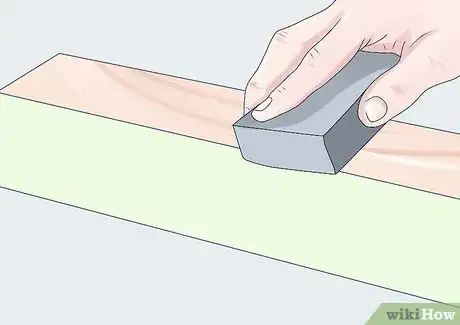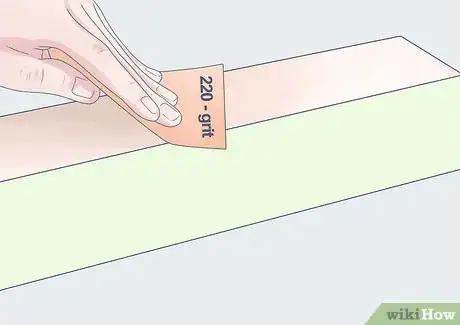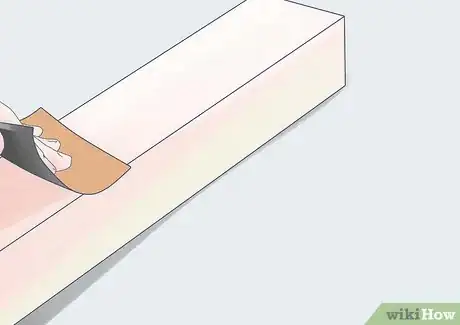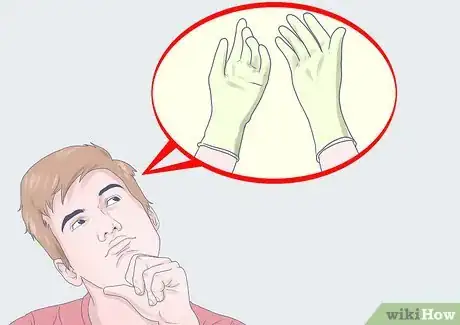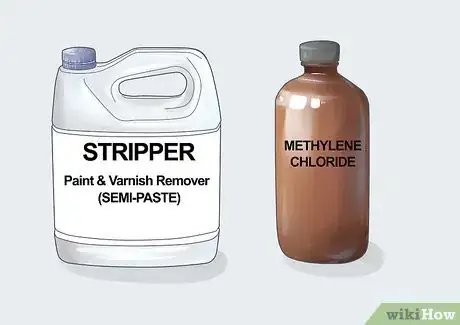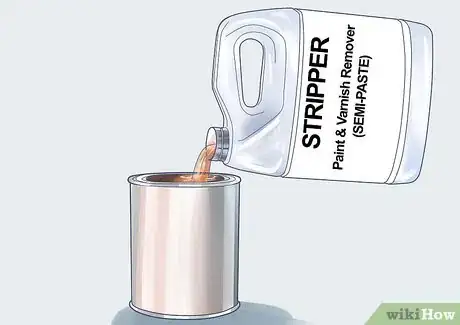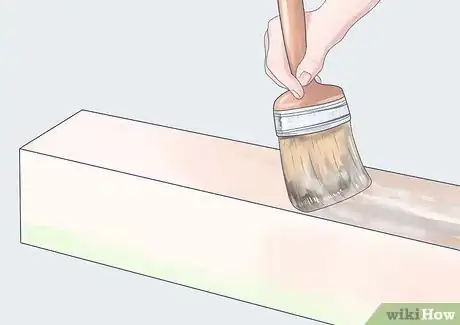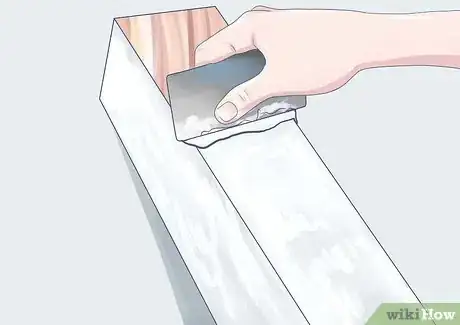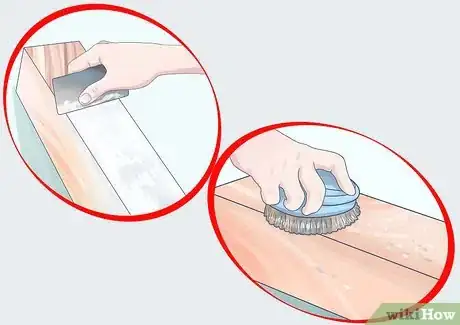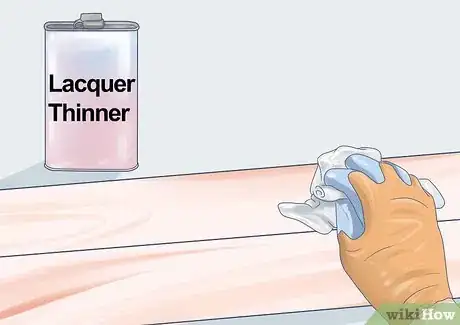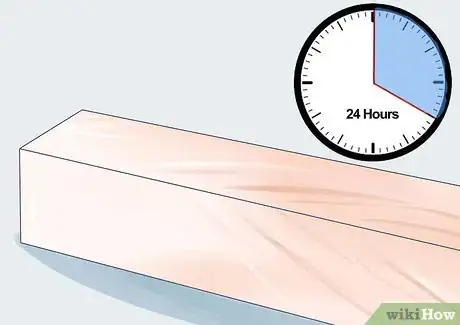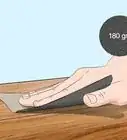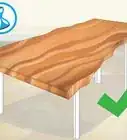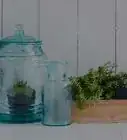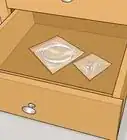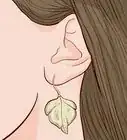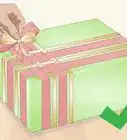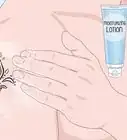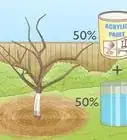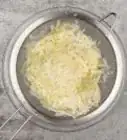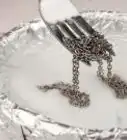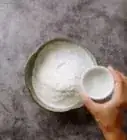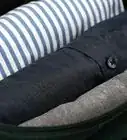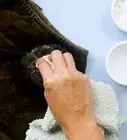X
wikiHow is a “wiki,” similar to Wikipedia, which means that many of our articles are co-written by multiple authors. To create this article, 11 people, some anonymous, worked to edit and improve it over time.
This article has been viewed 166,361 times.
Learn more...
You shouldn't throw away a piece of furniture or a nice piece of wood just because it has layers of old paint or old worn-out varnish on it. Instead, think about refinishing it. There could be a beautiful piece of wood under all that paint or varnish. It might just take you knowing how to strip wood finishes by sanding or using chemical strippers to find that beauty.
Steps
Method 1
Method 1 of 2:
Strip Wood Finishes With Sandpaper
-
1Wear a dust mask and protective goggles. Sanding old paint or varnish releases minute dust particles into the air that can irritate your eyes and lungs.
-
2Use coarse sandpaper to sand with the grain. Use a sanding sponge or wrap the sandpaper around a sanding block when stripping flat surfaces to ensure a smooth finish.Advertisement
-
3Switch the sandpaper to a medium grit once you begin to see the wood grain showing through the paint or the varnish starts to dull.
-
4Finish the job by sanding with fine-grit sandpaper. This will smooth out the wood and get rid of any remaining finish.[1]
Advertisement
Method 2
Method 2 of 2:
Strip Wood Finishes With Chemical Stripper
-
1Add chemical-resistant gloves to your protective clothing.[2]
-
2Place cardboard underneath the wood. This will catch all the drips from the stripper and protect the surface under the wood from unintentional damage.
-
3Decide which stripper you want to use. There are liquid and semi-paste strippers. Strippers with methylene chloride (MC) work faster and will remove almost all types of finishes.[3]
-
4Pour the stripper into an empty paint can or metal bucket.
-
5Use a brush to apply a very thick coat of the stripper onto the finish you want to strip. You can also spray the stripper onto the wood surface if you have the right tools to do so.[4]
-
6Try scraping the surface with a metal or plastic scraper to see whether the old paint or varnish is soft enough to scrape. This usually takes about 20 minutes; however, this can vary from 1 type of stripper to another.[5]
- If it is ready, the finish should come off without much effort. If it does not, allow the stripper to sit a little longer or add more stripper.
-
7Scrape the entire surface with your scraper. You can use a stiff cleaning brush with natural bristles or a heavy cleaning sponge to strip wood finishes in grooved areas.[6]
-
8Wipe down the wood with lacquer thinner using the brush or sponge. Once clean, wipe the wood with cotton rags. You may have to repeat this process a couple of times.
-
9Allow the wood to dry for 24 hours before re-coating it.
Advertisement
Community Q&A
-
QuestionWhat is lacquer thinner?
 Community AnswerLacquer thinner is a high-solvency, medium drying thinner for lacquer. It helps improve the flow and leveling when applying lacquer so your finish is smooth and streak free.
Community AnswerLacquer thinner is a high-solvency, medium drying thinner for lacquer. It helps improve the flow and leveling when applying lacquer so your finish is smooth and streak free. -
QuestionDoes varnish need to be removed before applying paint?
 TechdocgeekCommunity AnswerFor traditional painting projects, you should remove the varnish if you want the next coat of paint to last for a long time. However, If you're 'distressing' something and intending to show many layers, you could leave the varnish in place, or just partially removed.
TechdocgeekCommunity AnswerFor traditional painting projects, you should remove the varnish if you want the next coat of paint to last for a long time. However, If you're 'distressing' something and intending to show many layers, you could leave the varnish in place, or just partially removed. -
QuestionWhat is the best way to remove dark varnish from oak?
 TechdocgeekCommunity AnswerIf the varnish is still wet, you could remove it with a thinner and cloth as much as possible. If the varnish is already dry, you can sand it off.
TechdocgeekCommunity AnswerIf the varnish is still wet, you could remove it with a thinner and cloth as much as possible. If the varnish is already dry, you can sand it off.
Advertisement
Warnings
- The fumes from chemical strippers can be toxic. Make sure to strip paint or varnish in a well-ventilated area.⧼thumbs_response⧽
- Do not use MC stripper if you have an existing heart condition. This type of stripper may trigger a heart attack in those with heart trouble.⧼thumbs_response⧽
Advertisement
Things You'll Need
- Dust mask
- Goggles
- Coarse-grit sandpaper
- Sanding sponge or sanding block
- Medium-grit sandpaper
- Fine-grit sandpaper
- Chemical-resistant gloves
- Cardboard pieces
- Chemical stripper
- Paint can or metal bucket
- Paint brush or spray tools
- Scraper
- Stiff cleaning brush or heavy cleaning sponge
- Lacquer thinner
- Cotton rags
References
- ↑ https://www.bobvila.com/articles/how-to-remove-varnish/
- ↑ https://www.familyhandyman.com/woodworking/furniture-repair/stripping-furniture-tips-for-refinishing/
- ↑ https://www.bobvila.com/articles/how-to-remove-varnish/
- ↑ https://www.youtube.com/watch?v=bV74s1zo4a0
- ↑ https://www.thisoldhouse.com/how-to/how-to-refinish-woodwork
- ↑ https://www.lowes.com/n/how-to/refinish-wood-furniture
- http://www.refinishwizard.com/stripping_furniture.html
About This Article
Advertisement

